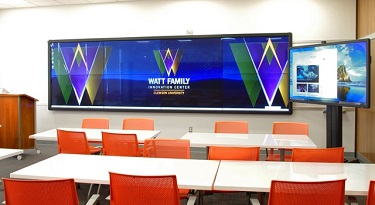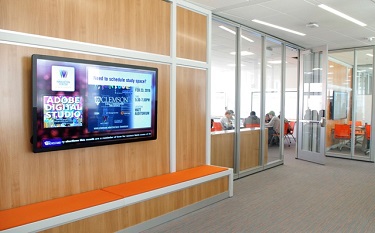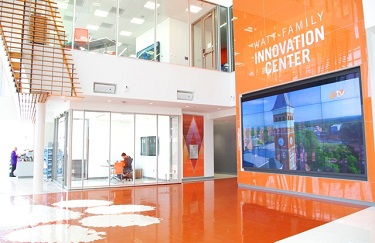The Watt Family Innovation Center Meets the Needs of Digitally Savvy Students

If ever there was an AV-enabled facility deserving of superlatives, it would be the Watt Family Innovation Center (The Watt). Located in the heart of the Clemson University campus in Clemson, South Carolina. Recently opened for classes and research, The Watt is a four-story, 70,000 square foot facility showcase of AV/IT-enabled education. It is equipped with 12 video walls ranging in size from 8' by 5' to 32' by 9'; a 13' by 8' 3D laser projector in The Watt’s auditorium; 191 large-screen HD touchscreen monitors and 73 space teaching/collaboration spaces equipped with AV equipment—all paid for using a generous $10 million AV equipment budget.

“There is an abundance of quality equipment specified in this project,” said Mike Parks. He is the Director of Technical Operations for ClarkPowell, the system integrator that created The Watt’s AV facilities along with AV systems designer BrightTree Studios, Pepperdash Technology Corporation, and Clemson University’s Watt staff. For instance, “utilizing a Crestron routing layer controlled with Crestron touch panels provides end users with a seamless, user-friendly operation of the systems,” Parks explained. “4K Planar video walls and interactive displays are present in most spaces throughout the building and SVSi networked digital media distribution allows the users to send content from any source to virtually any display within the building.”
That’s not all: “A very elaborate Biamp Tesira Server AVB solution handles the audio,” said Parks. “Other highlights include an 8x4 touch video wall (in the auditorium) with a total area of 270 square feet, and a 4x2 3D-capable 13.5’ video wall in their Cyberfusion room that allows students to view their renderings in 3D on a 15' wide display.”
A second 4x2 video wall is located in The Watt’s Seminar room. “It is 16’ wide and is touch-capable,” said David Vargo, Principal of BrightTree Studios. Meanwhile, The Watt’s outer skin is home to the largest LED media mesh screen in North America. Stretching almost the entire length of the building and covering 5,106-square-feet, the media mesh has more than 45,000 chip-on-board, clear-bodied LED nodes—and weighs 3,000 lbs.

As for workspaces: The Watt has a range of AV/IT-equipped classrooms, demonstration and immersive visualization areas, simulation and 3D modeling facilities, and rapid prototyping labs, plus meeting rooms of all sizes, a large auditorium and atrium, and even a rooftop terrace for social gatherings. The AV/IT equipment that drives it all is managed by a centralized control room within The Watt, with this building being able to link remotely to other AV/IT-equipped sites across South Carolina.
All of The Watt’s AV/IT hardware, plus the building’s four 10 Gbps broadband data networks, have combined to create the true ‘cutting-edge’ of AV/IT-enabled education. In this building, students, teachers and researchers have access to the most advanced, IP-connected multimedia technology for classroom teaching and presentations, multi-site videoconferences, and real-time lecture capture.
“In The Watt, we are able to bring together people, processes and resources to develop students who will be ready to go into the workplace and face future challenges,” said Dr. Dennis Lester, The Watt’s Associate Director. “They will not only be ready to work with the best that their employers have to offer, but be able to lead the way thanks to being taught using the very latest AV/IT technologies.” To reduce its impact on the environment, the Watt has been designed to meet LEED Silver/Gold environmental standards.
A daily selection of features, industry news, and analysis for tech managers. Sign up below.

Part of a Larger Plan
The Watt may be exceptional, but it is not an exception, at least not as far as Clemson University is concerned. That is because The Watt is a key element of this university’s ambitious ‘Clemson Forward,’ a strategy aimed at elevating Clemson to become one of the top 20 universities in the country. To fulfill this strategic plan, Clemson University plans to enhance student educational quality and performance by building the advanced facilities it needs to compete against America’s best colleges.
“In this respect, The Watt and our university strategic plan are nicely intertwined,” said Dr. Lester. “In fact, The Watt stemmed from work done during our pre-strategic planning, while the Clemson Forward strategy was being developed. The thinking was that an inter-disciplinary innovation center would help us in our bid to improve our quality of education and national competitiveness. Today, with this facility being used by 29 different departments, The Watt certainly hits this mark.”
The Watt’s AV/IT equipment has also been laid out to foster Clemson University’s notion of interactive, innovative active learning. “For instance, we have set up 98-inch classroom monitors so they can run in quad display mode,” said Vargo. “In this way, each group in a classroom can work on one quarter of the display, with everyone able to see and comment on everyone else’s work in real-time.”

BrightTree Studios won The Watt AV design contract through a competitive RFQ process. “We have experience in doing this kind of complex AV/IT design, including on-staff programmers who know how to make such sophisticated systems work,” Vargo said. “We were also able to foresee a number of issues inherent in the project that had not been spelled out in the RFP, and knew how to deal with them. This had an impact on Clemson University’s evaluation—and ultimate selection—of us as The Watt designer.”
The design process was spearheaded by BrightTree Studios and Clemson University. ClarkPowell and Pepperdash came on board after wards as the system integrator and programmer respectively. "In designing the technology for The Watt, it was extremely important to take a look into the future as well as a peek into the past,” said Vargo. “We met with multiple departments who were all using the space to get their input on how they currently work and collaborate. Our goal was then to facilitate innovation through the use of modern tools to enhance already existing collaboration efforts."
A Wealth of Technology
With a $10 million AV/IT budget, David Vargo was faced with a unique monetary problem. “With this much money available, it was hard to say no to anything,” he told AV Technology magazine. “It was a welcome problem to have, compared to the time pressures we faced to get The Watt built. On the other hand, it was necessary to show discipline in the equipment we did eventually choose, to ensure that it all worked together and fulfilled the project’s goals.”
This was no small feat, given just how much equipment and technology is packed into The Watt. A case in point: The entire facility is built with a 100 percent 4K-capable infrastructure utilizing Crestron's Cat7a cable and connections. “This insures that the center is as future-proofed as possible and can send 4K signals the greatest distance possible at this time,” said Mike Parks.

Meanwhile, the Crestron Fusion enterprise management platform “is being used to both schedule rooms and resources, and also to track usage of spaces and equipment,” Parks said. “This data allows Clemson University to monitor how their spaces are being used over time and will allow them to design more targeted functionality in their second generation spaces.” (Yes, The Watt’s managers are already planning for the second generation upgrade.) For the record,
Clark Powell programmed all of the on-campus digital signal processing units to optimize audio performance. Pepperdash Technology Corporation provided Crestron programming services and user interface development.
“echo360 is being used to capture lecture sessions in the engineering collaboration classrooms,” added Parks. “This provides instructors with the ability to create and share their content from anywhere, while giving the students the flexibility to view recorded lessons on their device of choice.”
In selecting and deploying the above technology (and much more than we have space to list here), David Vargo’s goal was to create AV-enabled learning spaces that would fulfill two roles. “On Day One, a classroom should be easy to use as a classroom,” he said. “On Day Two, those same users should be using technology in a much more advanced way. We want students and faculty to feel like they belong in the space. We want them to push the envelope of what is possible, and we can't wait to see what they come up with."

Challenges and Success
Building an AV/IT system as complex as The Watt posed unique challenges. For instance, the size of the facility pushed the limits of current technology’s ability to deliver uncompressed 4K/60fps content over long distances. This required the use of Crestron-certified CAT7a shielded cable which is capable of delivering 10Gbps bandwidth at distances of over 300 feet. Additionally, the requirement to deliver content from any source to any destination via the SVSi system meant that Clemson University needed very fast network switching, plus a tremendous amount of bandwidth within their network infrastructure.
“We also had to make 4,372 pieces of hardware from 65 different vendors work together,” said Dr. Lester. “Then there’s the issue of staying current: We are already looking ahead to our second generation upgrade within the next two-three years. That’s twice as fast as the usual academic IT refresh cycle, but a necessity given The Watt’s reputation for using the most advanced technology.” Fortunately, the building has its own integrated AV/IT team to stay on top of systems, and constantly look ahead.
Technology hasn’t been the only issue: “We had some delays during the build-out in sourcing furniture and even wall systems on time,” said David Vargo. “Our people ended up pulling some all-nighters to make sure that The Watt would be ready to open on time.”
Now that The Watt is open for business, the building’s managers are faced with another problem: Too much interest on campus and within the City of Clemson proper. “We have so many tours going through here, and so many events being booked, that they sometimes interfere with our classes,” said Dr. Barbara Speziale, Clemson University’s Associate Director for Academic Affairs. “It’s the sort of problem that should be welcome, but it does cause us issues from time to time.
It is too early to say whether The Watt’s exceptional AV/IT technology is furthering the University’s march along its Clemson Forward road-map. But what is already clear is how inspiring and engaging this new facility is for students, teachers, and researchers. “It helps that The Watt is a true interdisciplinary space not dominated by any one faculty,” Speziale observed. “This gives The Watt its own culture—one that is welcoming to everyone, rather than biased towards one faculty or another.”
Looking ahead, “We hope that the state-of-the-art Watt Family Innovation Center will be a showcase for the Clemson Campus while simultaneously setting the integrated collaboration benchmark for higher education campuses throughout the world,” said Mike Parks. “The goal is to combine user-friendly, cutting-edge technology with savvy digital age students, breeding diverse, immersive, collaborative environments.”
Ottawa-based James Careless is a regular contributor to AV Technology magazine. Photos by Robert Kirk Photography (robertkirkphotography.com).
INFO
BrightTree Studios
http://brighttreestudios.com
ClarkPowell
www.clark-powell.com
PepperDash
www.pepperdash.com
The Watt Family Innovation Center at Clemson University
http://www.clemson.edu/centers-institutes/watt/
James Careless is an award-winning freelance journalist with extensive experience in audio-visual equipment, AV system design, and AV integration. His credits include numerous articles for Systems Contractor News, AV Technology, Radio World, and TV Tech, among others. Careless comes from a broadcasting background, with credits at CBC Radio, NPR, and NBC News. He currently co-produces/co-hosts the CDR Radio podcast, which covers the Canadian defense industry. Careless is a two-time winner of the PBI Media Award for Excellence.

